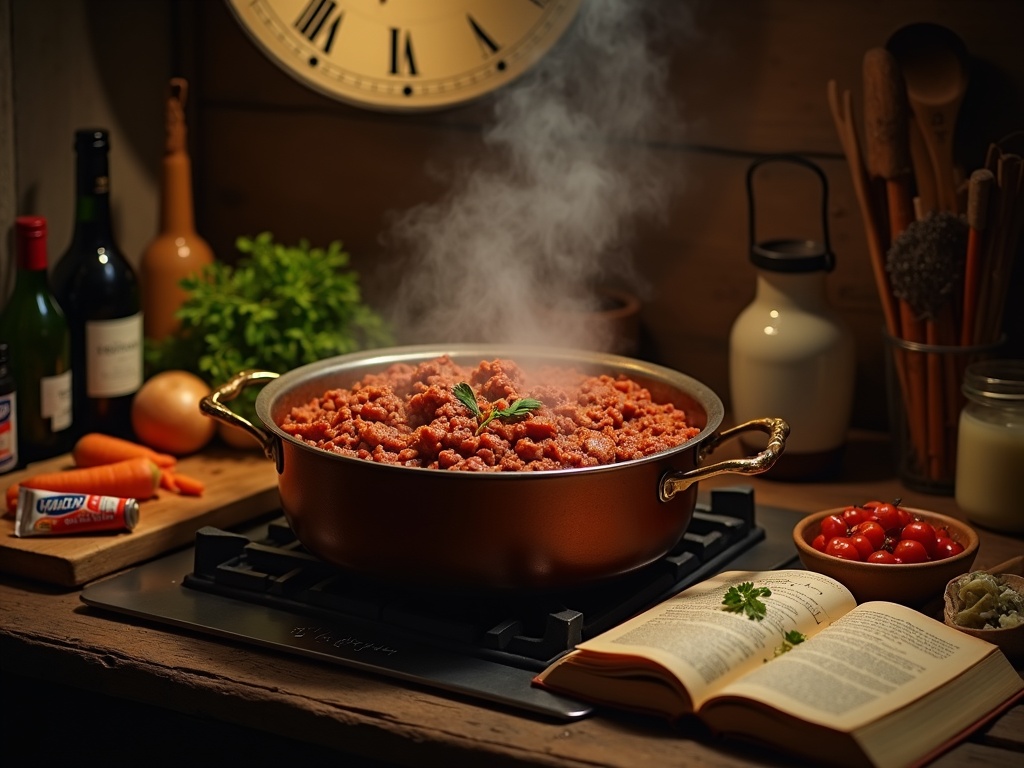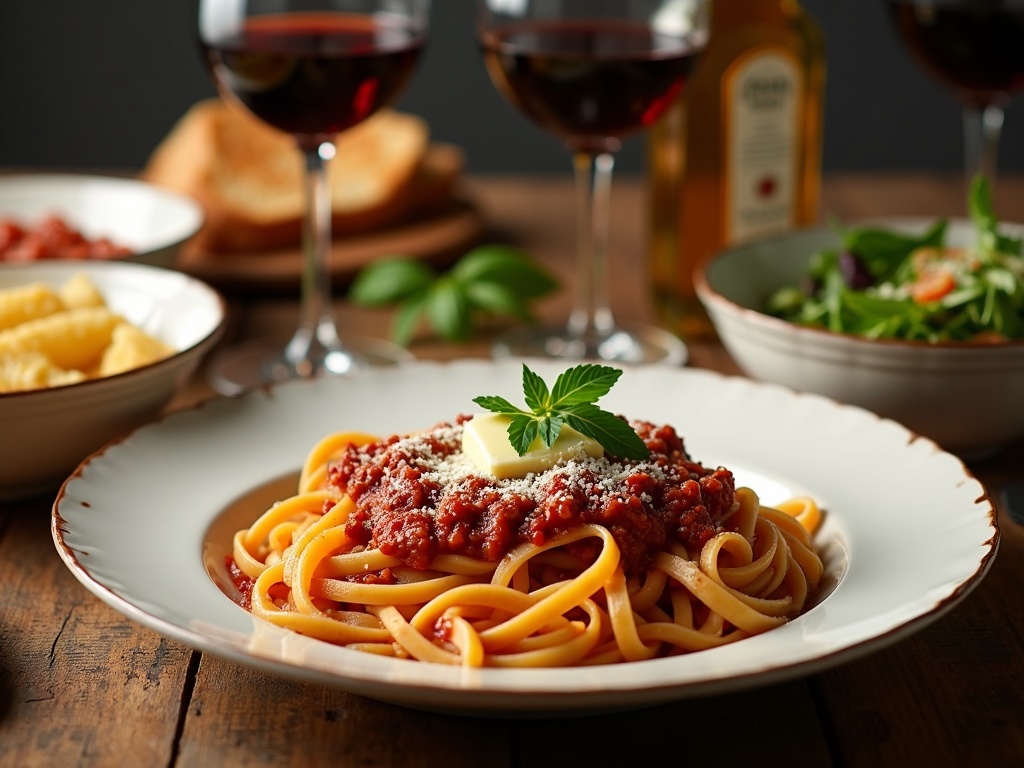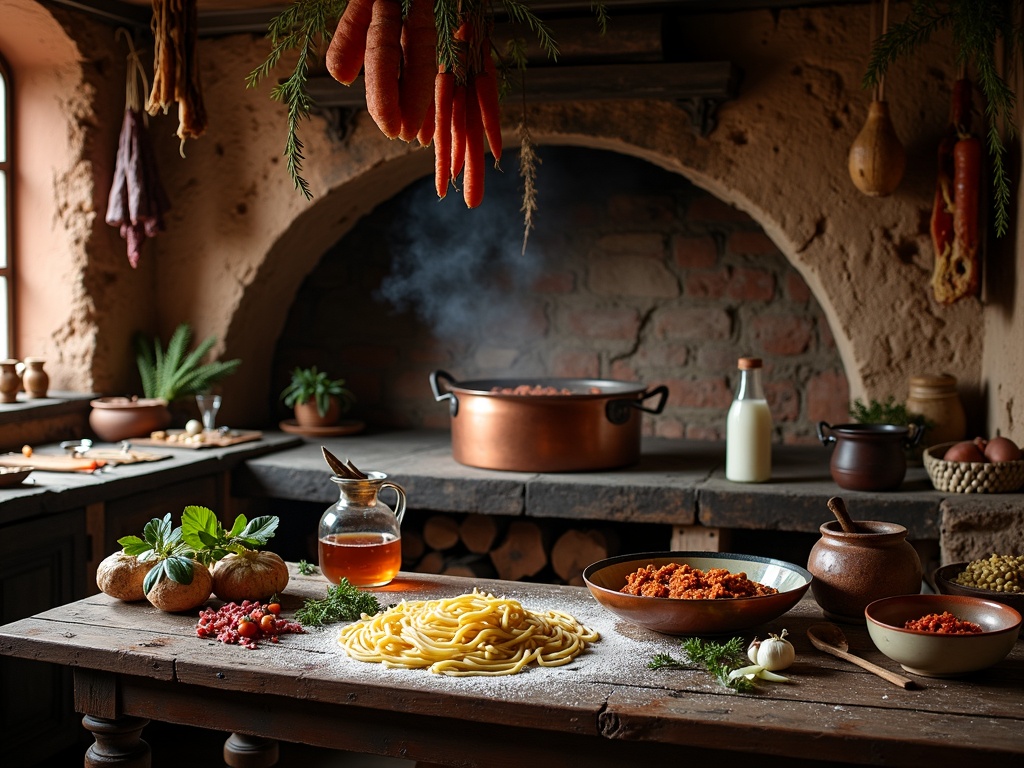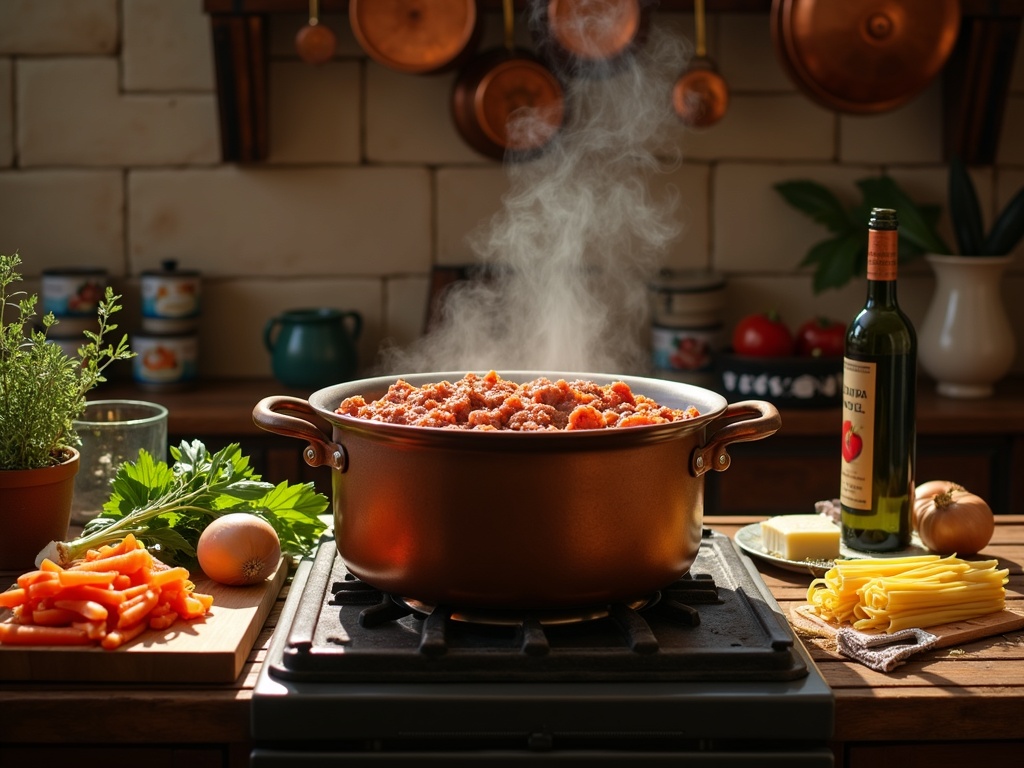Bolognese sauce recipe ranks as one of Italy’s most treasured culinary creations, known for its rich, meaty profile built through slow cooking and precise ingredient selection. This traditional ragù from Bologna differs greatly from tomato-heavy versions found outside Italy, instead centering on meat depth enhanced by soffritto, milk, and just a touch of tomato.
Table of Contents
Key Takeaways
- Authentic bolognese requires patience with a minimum 3–4 hour cooking time to develop its signature complex flavor profile.
- The traditional recipe uses a mix of ground meats (typically beef and pork), with fat content being crucial for richness and depth.
- The addition of milk helps tenderize the meat and creates the silky texture characteristic of genuine bolognese.
- Proper bolognese should be served with broad pasta like tagliatelle or pappardelle that can properly hold the thick sauce, not spaghetti.
- The sauce actually improves when made a day ahead, allowing flavors to further develop and meld together overnight.
What Makes Bolognese Special
Bolognese sauce stands as one of the most iconic Italian culinary treasures that has captured hearts worldwide. This rich, meaty sauce originated in Bologna, Italy, and has become synonymous with comfort food across continents. Its deep, complex flavor profile sets it apart from other pasta sauces, making it a favorite for special family dinners and gatherings.
The Authentic Italian Tradition
Authentic ragù alla bolognese differs significantly from what many Americans know as “spaghetti bolognese.” The traditional recipe involves a slow-cooked sauce that combines ground meat (typically beef and pork), soffritto (finely chopped carrots, celery, and onions), milk, and just a touch of tomato. This creates a thick, meat-forward sauce rather than the tomato-heavy versions often served outside Italy.
The secret to authentic bolognese lies in these key elements:
- Patience with cooking time – true bolognese simmers for hours, allowing flavors to meld and develop
- Minimal tomato content – just enough to add acidity and color
- Addition of milk – creates richness and helps tenderize the meat
- Proper meat selection – traditionally a mix of beef, pork, and sometimes veal
I’ve discovered that the cooking technique matters tremendously. Italians typically start by sautéing the soffritto until soft and fragrant, then browning the meat until it develops a deep caramelization. This foundational step creates the flavor base that makes bolognese so distinctive.
What truly sets bolognese apart is its versatility. While many think of it paired with spaghetti, Italians traditionally serve it with tagliatelle – flat, wide pasta ribbons that hold the thick sauce perfectly. It’s also the star component in classic lasagna recipes and can transform simple polenta into an extraordinary meal.
The sauce’s history dates back centuries in the Emilia-Romagna region, where it evolved from simple meat preparations into the complex sauce we know today. Each family in Bologna claims their recipe as the definitive version, with small variations passed through generations.
Unlike many quick-cook pasta sauces like fresh pesto or simple marinara, bolognese rewards those who take their time. The slow cooking process allows the flavors to intensify and the meat to become incredibly tender. This isn’t a weeknight quick dinner but rather a labor of love that pays off in incredible flavor.
The cultural significance of bolognese extends beyond its taste. In Italy, the preparation of ragù is often a social activity, bringing families together for Sunday lunch preparations. The gentle bubbling of the sauce on the stove signals the upcoming gathering around the table.
Essential Ingredients for Success
The heart of any authentic bolognese sauce lies in its ingredients. Getting these components right sets the foundation for a rich, flavorful sauce that will transform your favorite Italian dishes from good to exceptional.
Primary Components
For the meat base, I recommend using ground beef with an 80/20 lean-to-fat ratio. This balance provides enough fat to carry flavor while keeping the sauce from becoming greasy. Adding ground pork introduces a subtle sweetness that complements the beef perfectly.
The aromatic foundation begins with a classic soffritto—a mix of finely diced yellow onion, carrots, and celery. This trio creates a sweet, earthy base that forms the backbone of the sauce. Minced garlic cloves add another dimension of flavor when gently sautéed with the vegetables.
For the tomato elements, I’ve found that using both crushed tomatoes and tomato paste delivers the perfect consistency and depth. The paste adds concentrated flavor while the crushed tomatoes contribute brightness and texture to your homemade lasagna recipe.
The following items play crucial supporting roles in an authentic bolognese:
- Whole milk: Adds richness and helps tenderize the meat
- Bay leaves: Infuse earthy notes during the long simmer
- Fresh herbs: Thyme for earthiness and fresh basil for brightness
- Salt and pepper: Essential for balanced seasoning throughout cooking
- Olive oil: Use a good quality oil for sautéing your soffritto
What makes these ingredients work so well together is their ability to develop complexity during the slow cooking process. The milk might seem unusual if you’re unfamiliar with traditional Italian recipes, but it’s a key authentic element that helps break down the meat proteins and adds silky texture.
I find that hand-chopping the vegetables rather than using a food processor gives better texture and allows for more controlled cooking. The vegetables should be diced small enough to almost melt into the sauce during cooking.
The quality of ingredients makes a significant difference. While grocery store basics will create a tasty sauce, upgrading even one element—like using San Marzano tomatoes or locally-raised grass-fed beef—can elevate your bolognese to new heights.
For herbs, fresh is definitely preferred over dried, but if using dried herbs, add them earlier in the cooking process to allow their flavors to fully release. Fresh herbs should be added near the end to preserve their bright notes.
With these essential ingredients on hand, you’re fully prepared to create a bolognese sauce that honors tradition while satisfying modern palates. The magic happens when these elements come together during the long, slow simmer, creating a sauce that’s far greater than the sum of its parts.

Step-by-Step Cooking Method of Bolognese Sauce Recipe
Developing a rich, flavorful bolognese sauce requires patience and attention to several critical cooking stages. The slow build-up of flavors is what transforms simple ingredients into a hearty sauce that stands as one of the most beloved Italian culinary traditions. Let’s break down each crucial step of the process.
Building Layers of Flavor
I start by sautéing the vegetable base, known in Italian cooking as soffritto. Heat olive oil in a large, heavy-bottomed pot over medium heat until shimmering. Add finely diced onions first, cooking for about 5 minutes until translucent but not browned. Next, add the carrots and celery, continuing to cook for another 7–8 minutes. This slow cooking process caramelizes the vegetables slightly, creating a sweet foundation for the sauce. The vegetables should be soft enough that they’ll eventually melt into the sauce during the long simmering period.
After the vegetables have softened, it’s time to brown the meat properly. This step can’t be rushed as it’s crucial for developing depth of flavor. I add the ground meat (typically beef, or a mix of beef and pork) to the pot, breaking it up with a wooden spoon. The key is to let the meat develop a deep brown color before stirring. This means letting it sit undisturbed for a minute or two before breaking it up further. Continue cooking until all the meat has lost its raw, pink color and has taken on a golden-brown hue.
The next stage involves adding tomatoes to create the sauce base. Whether using fresh or canned, I make sure to break down any large pieces for a more uniform sauce. After the tomatoes are incorporated, I add milk in a slow stream while stirring continuously. This might seem unusual if you’re new to authentic Italian recipes, but milk adds richness and helps tenderize the meat, as well as moderating the acidity of the tomatoes.
Now comes the most important part of making bolognese: the long, slow simmer. I reduce the heat to the lowest setting possible, ensuring the sauce barely bubbles. A proper bolognese needs to simmer for at least 2–3 hours, though 4 hours yields even better results. During this time, I stir occasionally and add a splash of broth or water if the sauce becomes too thick. The pot should remain partially covered to allow some reduction while preventing excessive moisture loss.
The sauce will gradually transform, with the meat becoming incredibly tender and the flavors melding together beautifully. As it simmers, the sauce will darken and thicken naturally. About 30 minutes before the end of cooking, I taste and make final seasoning adjustments. Salt and freshly ground black pepper are essential, but I might also add a pinch of nutmeg for authenticity.
Throughout this process, patience is your greatest ally. Unlike quick-cooking pasta sauces like a simple pesto, bolognese demands time to develop its characteristic rich, complex flavor profile. The result is a deeply satisfying sauce that pairs perfectly with tagliatelle, pappardelle, or as the meat layer in a classic lasagna.
Remember that bolognese actually tastes better the day after cooking, making it an ideal make-ahead dish for entertaining or busy weeknights. The overnight rest allows the flavors to meld even further, creating an even more delicious result.
Common Mistakes to Avoid
Making a perfect bolognese sauce requires patience and attention to detail. After cooking countless batches over the years, I’ve identified several pitfalls that can turn your sauce from extraordinary to ordinary. Let me guide you through these common errors so you can achieve that rich, complex flavor that makes an authentic Italian bolognese so memorable.
Rushing the Cooking Process
Bolognese isn’t fast food. The magic happens through slow simmering that allows flavors to meld together beautifully. I’ve found that a minimum of 3-4 hours of cooking creates that depth of flavor that makes bolognese special. When you rush the process, the meat becomes tough rather than tender, and the sauce lacks complexity.
I remember my first attempt at making bolognese — I cooked it for just an hour and wondered why it tasted one-dimensional. The transformation that happens in those additional hours is remarkable — the sauce becomes richer, the meat more tender, and all the ingredients harmonize into something greater than their parts.
Ingredient Mistakes That Compromise Flavor
Using lean meat only is a common misstep. Bolognese benefits from the richness of fattier cuts. I recommend using a blend — perhaps equal parts ground beef, pork, and veal for the ideal balance of flavor and texture. The fat renders during cooking, infusing the sauce with richness that lean meat simply can’t provide.
Skipping the milk might seem like a minor oversight, but it’s crucial for authentic bolognese. Milk adds silkiness to the texture and helps tenderize the meat. I typically add it after browning the meat but before adding tomatoes, allowing it to reduce completely before moving forward.
Under-seasoning remains one of the biggest culprits behind bland bolognese. The sauce needs adequate salt to bring out all those complex flavors you’ve been building. I taste and adjust seasoning throughout the cooking process, not just at the end. Remember that the sauce will be served with pasta, which may not be heavily salted on its own.
Adding too much tomato transforms your bolognese into a tomato sauce with meat rather than a true meat sauce. In authentic lasagna bolognese, meat is the star, with tomatoes playing a supporting role. I usually add just enough tomato to provide acidity and color — typically around 2-3 tablespoons of paste plus perhaps one can of crushed tomatoes for a large batch.
I once made the mistake of adding too many tomatoes and essentially created a meat-flavored marinara. While tasty, it wasn’t the rich, meat-forward sauce that defines true bolognese. Remember that traditional bolognese from Bologna is more brown than red, with just enough tomato to balance the richness.
The beauty of mastering proper bolognese technique is that these skills transfer to other Italian classics as well. Taking time with each step, respecting traditional ingredients, and allowing flavors to develop fully will elevate not just your bolognese but many of your cooking projects.

Pro Tips for the Best Results
The difference between a good bolognese sauce and an exceptional one often comes down to technique. I’ve gathered several professional tips that will elevate your traditional Italian sauce to restaurant quality.
Perfecting the Cooking Process
Cooking bolognese sauce on low heat for 3-4 hours is crucial. This slow simmer allows the flavors to develop fully and the meat to become incredibly tender. The patience required here pays off tremendously in the final product. Quick-cooked bolognese simply can’t match the depth of flavor that comes from this extended cooking time.
I always start with room temperature ingredients. Cold ingredients can lower the pan temperature too dramatically, which disrupts the browning process essential for developing flavor. Taking your meat, vegetables out of the refrigerator 30 minutes before cooking makes a noticeable difference.
Don’t forget to stir the sauce occasionally throughout the cooking process. This prevents any scorching at the bottom of the pot and ensures even heat distribution. I find that stirring every 15-20 minutes works perfectly—frequent enough to prevent burning but not so often that you’re constantly disrupting the cooking process.
When combining your sauce with pasta, add a splash of pasta cooking water. This starchy water helps bind the sauce to the pasta and creates a silky texture that coats each strand or piece perfectly. About 1/4 cup of pasta water per pound of pasta is my standard measurement for perfect pasta dishes every time.
Serving and Storage Secrets
Let your bolognese sauce rest for 10–15 minutes before serving. Similar to how meat benefits from resting after cooking, this brief pause allows the flavors to settle and intensify. The difference in taste is subtle but significant.
Here are some key storage tips for your bolognese sauce:
- Cool the sauce completely before refrigerating to prevent condensation inside the storage container
- Store in an airtight glass container rather than plastic to prevent staining and potential chemical leaching
- Refrigerate for up to 4 days or freeze portions for up to 3 months
- Label frozen portions with dates to keep track of freshness
- Thaw frozen sauce overnight in the refrigerator for best texture
One of my favorite sauce techniques is purposely making extra bolognese to enjoy the next day. The flavor actually improves overnight as the ingredients have more time to meld together. Many Italian chefs and home cooks alike swear by day-old bolognese, claiming it’s even better than freshly made.
When reheating, do so gently on low heat with a splash of water or broth to loosen the sauce as it will have thickened in the refrigerator. If you’ve created a truly authentic Italian specialty, you’ll notice how the flavors have married even more beautifully overnight.
By following these professional tips, you’ll create a bolognese sauce that rivals what you’d find in top Italian restaurants. The extra attention to detail transforms this humble meat sauce into something truly special that will impress family and friends alike.
Serving Suggestions
Bolognese sauce is a versatile Italian classic that deserves to be paired with the right ingredients to truly shine. I’ll share how to serve this rich meat sauce for the best dining experience, from pasta selection to reheating techniques.
Perfect Pasta Partners and Plating
Traditional Italian cuisine pairs bolognese with specific types of pasta that hold the meaty sauce perfectly. The best classic options include:
- Tagliatelle – This ribbon-like pasta is the authentic Bolognese choice in Italy
- Pappardelle – Wider ribbons that capture generous amounts of sauce
- Fettuccine – Similar to tagliatelle but slightly narrower
- Rigatoni – The tube shape and ridges trap sauce inside and out
- Conchiglie (shells) – The curved shape creates perfect sauce pockets
The right sauce-to-pasta ratio makes all the difference in traditional Italian pasta dishes. For bolognese, I aim for approximately 3–4 tablespoons of sauce per serving of pasta. This provides enough coating without drowning the pasta. Remember that authentic Italian pasta dishes aren’t swimming in sauce — the pasta itself should remain the star with the sauce as its enhancement.
When plating, toss the pasta with about two-thirds of your sauce in the pan before serving, then top with the remaining sauce. This technique ensures every strand gets properly coated. For an extra touch of richness, add a small pat of butter when tossing for glossiness.
Garnishing elevates your bolognese from good to exceptional. Fresh grated Parmigiano-Reggiano is essential, with Pecorino Romano offering a sharper alternative. Fresh herbs like basil or parsley add color and brightness. For an elegant presentation, add a small drizzle of high-quality extra virgin olive oil just before serving. These simple touches can transform your homemade pasta creations into restaurant-worthy plates.
Storage and Reheating Tips
Proper storage extends the life and flavor of your bolognese sauce. Once cooled, store it in airtight containers in the refrigerator for 3–4 days. For longer storage, freeze portions in freezer-safe containers or bags for up to 3 months. I recommend freezing in meal-sized portions for easier defrosting.
When reheating, thaw frozen sauce overnight in the refrigerator for best results. Gentle reheating preserves flavor and texture — use a saucepan over medium-low heat, stirring occasionally and adding a splash of water or broth if needed to restore consistency. Avoid microwave reheating if possible, as it can create hot spots and uneven warming.
Bolognese sauce improves with time as flavors continue to develop. Many Italian appetizer and main course recipes benefit from this same effect. I often make bolognese a day ahead of serving for even richer flavor profiles.
Full Italian Dinner Experience
For a complete Italian dinner experience, consider starting with a light antipasto like homemade bruschetta to balance the richness of the main course. Simple sides like a crisp green salad dressed with lemon and oil or sautéed green vegetables provide welcome freshness alongside the hearty main dish.

Historical Background
Bolognese sauce, or ragù alla bolognese, can trace its origins to the historic city of Bologna in northern Italy. This rich, meat-based sauce has become a cornerstone of authentic Italian cuisine and has a fascinating story that spans centuries of culinary evolution.
The earliest documented recipes for what we might recognize as bolognese appeared in the late 18th century. Initially, these early versions were quite different from what most people know today. They contained significantly less tomato than modern recipes, focusing instead on the slow cooking of meat with broth, and just a hint of tomato for color and flavor.
Traditional Methods and Evolution
Traditional preparation of authentic bolognese sauce involves specific techniques that have been passed down through generations:
- Soffritto base: Starting with finely chopped onions, carrots, and celery sautéed in fat
- Meat selection: Using a combination of ground beef and pork for depth of flavor
- Slow simmering: Cooking the sauce for 3–4 hours minimum to develop complex flavors
- Minimal tomato: Using just enough tomato to add color and slight acidity
- Dairy finish: Adding milk or cream toward the end of cooking
The recipe has evolved significantly over time. Early versions prepared in Bologna used very little tomato paste, as tomatoes weren’t widely available in northern Italy until the early 19th century. The official recipe, registered in 1982 by the Accademia Italiana della Cucina, specifically calls for beef skirt, cartella (thin diaphragm), and pancetta, with a small amount of tomato paste or fresh tomatoes.
Interestingly, the version most people outside Italy know—with abundant tomato sauce and often served with spaghetti—would be unrecognizable to Bolognese traditionalists. In Bologna, the sauce is typically paired with homemade lasagna or tagliatelle, never spaghetti. The pasta’s shape and texture are specifically chosen to hold the heavy meat sauce effectively.
Regional variations showcase Italy’s diverse culinary landscape:
- In Naples, their ragù tends to use whole cuts of meat instead of ground
- Tuscan versions might include herbs like rosemary
- The Emilia-Romagna region (where Bologna is located) maintains the most traditional preparation methods
The cultural significance of bolognese sauce extends far beyond Italy. This sauce represents the importance of taking time with food preparation and the value of using simple ingredients to create something extraordinary. Unlike quick meals, authentic bolognese requires patience and care—a reflection of Italian dining philosophy where meals are meant to be savored together.
In Bologna itself, the preparation of ragù remains a point of fierce pride. Just as traditional bruschetta varies between Italian regions, bolognese has its strict traditions. Many families maintain their own slight variations passed down through generations, each claiming theirs as the definitive version.
The international popularity of bolognese sauce grew dramatically after World War II when American and British soldiers returned home having tasted Italian cuisine. However, what spread globally was often an adapted version with more tomatoes and less complexity than the original. This transformation points to how recipes change as they cross cultural boundaries, adapting to local tastes and available ingredients.
Understanding the history of bolognese sauce enhances appreciation for this beloved dish. The next time you prepare it, consider trying a more traditional approach—the slow-cooked richness and complex flavors of authentic bolognese might forever change how you think about this Italian classic.


